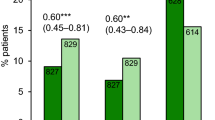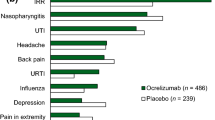Abstract
Daclizumab (Zinbryta®; previously known as daclizumab high-yield process) is a therapeutic monoclonal antibody that has recently been approved for the treatment of relapsing forms of multiple sclerosis (MS) in adults. Daclizumab is a humanized IgG1 monoclonal antibody directed against CD25, the alpha subunit of the high-affinity interleukin-2 receptor. As demonstrated in the phase III DECIDE trial, once-monthly subcutaneous daclizumab was superior to once-weekly intramuscular interferon (IFN) β-1a in reducing the clinical relapse rate and radiological measures of disease in patients with relapsing-remitting MS. In addition, daclizumab has demonstrated efficacy in reducing disability progression and in improving health-related quality of life in patients with relapsing MS. Ongoing open-label clinical trials indicate that daclizumab’s efficacy is maintained in the longer term (3 years or more). Daclizumab appears to be generally well tolerated, with adverse events of interest (including hepatic, infectious and cutaneous events) generally manageable with regular monitoring and/or standard therapies. The place of daclizumab in MS treatment remains to be fully determined. However, based on available evidence, daclizumab provides a useful alternative option to other currently available disease-modifying therapies in the treatment of relapsing MS.

Similar content being viewed by others
References
Compston A, Coles A. Multiple sclerosis. Lancet. 2008;372(9648):1502–17.
Nylander A, Hafler DA. Multiple sclerosis. J Clin Investig. 2012;122(4):1180–8.
National Multiple Sclerosis Society. What is MS? 2016. http://www.nationalmssociety.org/What-is-MS. Accessed 23 Sept 2016.
National Institute for Health and Care Excellence. Multiple sclerosis in adults: management. 2014. https://www.nice.org.uk/guidance/cg186. Accessed 20 Jan 2017.
Rejdak K, Jackson S, Giovannoni G. Multiple sclerosis: a practical overview for clinicians. Br Med Bull. 2010;95:79–104.
Ali R, Nicholas RSJ, Muraro PA. Drugs in development for relapsing multiple sclerosis. Drugs. 2013;73(7):625–50.
Wingerchuk DM, Weinshenker BG. Disease modifying therapies for relapsing multiple sclerosis. BMJ. 2016;354:i3518.
Gold R. Oral therapies for multiple sclerosis: a review of agents in phase III development or recently approved. CNS Drugs. 2011;25(1):37–52.
Ingwersen J, Aktas O, Hartung H-P. Advances in and algorithms for the treatment of relapsing-remitting multiple sclerosis. Neurotherapeutics. 2016;13(1):47–57.
Fontoura P. Monoclonal antibody therapy in multiple sclerosis: paradigm shifts and emerging challenges. MAbs. 2010;2(6):670–81.
European Medicines Agency. Zinbryta: summary of product characteristics. 2016. http://www.ema.europa.eu. Accessed 20 Jan 2017.
US FDA. Zinbryta (daclizumab) injection: US prescribing information. 2016. http://www.fda.gov. Accessed 20 Jan 2017.
Bielekova B. Daclizumab therapy for multiple sclerosis. Neurotherapeutics. 2013;10(1):55–67.
Ganguly B, Balasa B, Efros L, et al. The CD25-binding antibody daclizumab high-yield process has a distinct glycosylation pattern and reduced antibody-dependent cell-mediated cytotoxicity in comparison to Zenapax®. MAbs. 2016;8(7):1417–24.
Wang X, Rickert M, Garcia KC. Structure of the quaternary complex of interleukin-2 with its α, β, and γc receptors. Science. 2005;310(5751):1159–63.
Martin JF, Perry JSA, Jakhete NR, et al. An IL-2 paradox: blocking CD25 on T cells induces IL-2-driven activation of CD56bright NK cells. J Immunol. 2010;185(2):1311–20.
Huss DJ, Mehta DS, Sharma A, et al. In vivo maintenance of human regulatory T cells during CD25 blockade. J Immunol. 2015;194(1):84–92.
Diao L, Hang Y, Othman AA, et al. Population PK-PD analyses of CD25 occupancy, CD56bright NK cell expansion, and regulatory T cell reduction by daclizumab HYP in subjects with multiple sclerosis. Br J Clin Pharmacol. 2016;82(5):1333–42.
Wuest SC, Edwan JH, Martin JF, et al. A role for interleukin-2 trans-presentation in dendritic cell-mediated T cell activation in humans, as revealed by daclizumab therapy. Nat Med. 2011;17(5):604–9.
Minocha M, Tran JQ, Sheridan JP, et al. Blockade of the high-affinity interleukin-2 receptors with daclizumab high-yield process: pharmacokinetic/pharmacodynamic analysis of single- and multiple-dose phase I trials. Clin Pharmacokinet. 2016;55(1):121–30.
Bielekova B, Catalfamo M, Reichert-Scrivner S, et al. Regulatory CD56bright natural killer cells mediate immunomodulatory effects of IL-2Rα-targeted therapy (daclizumab) in multiple sclerosis. Proc Natl Acad Sci USA. 2006;103(15):5941–6.
European Medicines Agency. European public assessment report: Zinbryta (daclizumab). 2016. http://www.ema.europa.eu. Accessed 19 Jan 2017.
Elkins J, Sheridan J, Amaravadi L, et al. CD56bright natural killer cells and response to daclizumab HYP in relapsing-remitting MS. Neurol Neuroimmunol Neuroinflamm. 2015;2(2):e65.
Gold R, Giovannoni G, Selmaj K, et al. Daclizumab high-yield process in relapsing-remitting multiple sclerosis (SELECT): a randomised, double-blind, placebo-controlled trial. Lancet. 2013;381(9884):2167–75.
Giovannoni G, Gold R, Selmaj K, et al. Daclizumab high-yield process in relapsing-remitting multiple sclerosis (SELECTION): a multicentre, randomised, double-blind extension trial. Lancet Neurol. 2014;13(5):472–81.
Lin YC, Winokur P, Blake A, et al. Daclizumab reverses intrathecal immune cell abnormalities in multiple sclerosis. Ann Clin Transl Neurol. 2015;2(5):445–55.
Perry JSA, Han S, Xu Q, et al. Inhibition of LTi cell development by CD25 blockade is associated with decreased intrathecal inflammation in multiple sclerosis. Sci Transl Med. 2012;4(145):145ra06.
Gillard GO, Saenz SA, Huss DJ, et al. Circulating innate lymphoid cells are unchanged in response to DAC HYP therapy. J Neuroimmunol. 2016;294:41–5.
Oh U, Blevins G, Griffith C, et al. Regulatory T cells are reduced during anti-CD25 antibody treatment of multiple sclerosis. Arch Neurol. 2009;66(4):471–9.
Mehta D, Reister K, Sheridan J, et al. Rapid, sustained and reversible pharmacodynamics of DAC HYP in MS patients supports mechanism of action via modulation of the IL-2 pathway [abstract no. P972]. Mult Scler. 2014;20(Suppl 1):491–2.
Lin YC, Winokur P, Blake A, et al. Patients with MS under daclizumab therapy mount normal immune responses to influenza vaccination. Neurol Neuroimmunol Neuroinflamm. 2016;3(1):e196.
Mehta L, Umans K, Ozen G, et al. Immune response to seasonal influenza vaccine in relapsing-remitting multiple sclerosis patients on long-term daclizumab in a prospective, open-label, single-arm study. Int J MS Care. 2017. doi:10.7224/1537-2073.2016-026.
Diao L, Hang Y, Othman AA, et al. Population pharmacokinetics of daclizumab high-yield process in healthy volunteers and subjects with multiple sclerosis: analysis of phase I-III clinical trials. Clin Pharmacokinet. 2016;55(8):943–55.
Othman AA, Tran JQ, Tang MT, et al. Population pharmacokinetics of daclizumab high-yield process in healthy volunteers: integrated analysis of intravenous and subcutaneous, single- and multiple-dose administration. Clin Pharmacokinet. 2014;53(10):907–18.
Tran JQ, Othman AA, Mikulskis A, et al. Pharmacokinetics of daclizumab high-yield process with repeated administration of the clinical subcutaneous regimen in patients with relapsing-remitting multiple sclerosis. Clin Pharmacol. 2016;8:9–13.
Kappos L, Wiendl H, Selmaj K, et al. Daclizumab HYP versus interferon beta-1a in relapsing multiple sclerosis. N Engl J Med. 2015;373(15):1418–28.
Gold R, Radue E-W, Giovannoni G, et al. Safety and efficacy of daclizumab in relapsing-remitting multiple sclerosis: 3-year results from the SELECTED open-label extension study. BMC Neurol. 2016;16:117.
Kappos L, Cohan S, Arnold DL, et al. Interim report on the safety and efficacy of long-term daclizumab HYP treatment for up to 5 years in EXTEND [abstract no. P653 plus poster]. In: 32nd Congress of the European Committee for Treatment and Research in Multiple Sclerosis. 2016.
Rose J, Wiendl H, Arnold D, et al. Daclizumab HYP reduced brain MRI lesion activity compared with interferon beta-1a: results from the DECIDE study [abstract no. P7.252]. Neurology. 2015;84(14 Suppl):P7.252.
Giovannoni G, Greenberg S, Tsao C, et al. Efficacy of daclizumab HYP across subgroups of varying relapsing-remitting multiple sclerosis disease severity: results from the SELECT study [abstract no. EP1152]. J Neurol. 2014;261(Suppl 1):S94.
Wiendl H, Havrdova E, Rose J, et al. Daclizumab HYP versus interferon β-1a across patient demographic and disease activity subgroups in the DECIDE phase 3 study [abstract no. P4.007]. Neurology. 2015;84(14 Suppl):P4.007.
Wiendl H, Kappos L, Selmaj K, et al. Daclizumab high-yield process (DAC HYP) vs. interferon beta-1a in patients with highly active disease: DECIDE study results [abstract no. O1218]. Eur J Neurol. 2015;22(Suppl 1):50.
Giovannoni G, Ziemssen T, Ma W, et al. Daclizumab HYP efficacy on disease outcome measures using an expanded definition of highly active relapsing-remitting multiple sclerosis: results from SELECT and DECIDE [abstract no. P31133 plus poster]. Eur J Neurol. 2016;23(Suppl 2):663.
Havrdova E, Kappos L, Selmaj K, et al. The efficacy and safety of daclizumab high-yield process (DAC HYP) in patients previously treated with disease-modifying therapies: subgroup analyses from the DECIDE study [abstract no. P1158]. Eur J Neurol. 2015;22(Suppl 1):152.
Polman CH, Reingold SC, Edan G, et al. Diagnostic criteria for multiple sclerosis: 2005 revisions to the “McDonald Criteria”. Ann Neurol. 2005;58(6):840–6.
Phillips GA, Wyrwich KW, Guo S, et al. Responder definition of the Multiple Sclerosis Impact Scale physical impact subscale for patients with physical worsening. Mult Scler. 2014;20(13):1753–60.
Phillips G, Guo S, Bender R, et al. Assessing the impact of multiple sclerosis disease activity and daclizumab HYP treatment on patient-reported outcomes: results from the SELECT trial. Mult Scler Relat Disord. 2016;6:66–72.
Liu Y, Vollmer T, Havrdova E, et al. Impact of daclizumab versus interferon beta-1a on patient-reported outcomes in relapsing-remitting multiple sclerosis. Mult Scler Relat Disord. 2017;11:18–24.
Giovannoni G, Radue E-W, Havrdova E, et al. Effect of daclizumab high-yield process in patients with highly active relapsing-remitting multiple sclerosis. J Neurol. 2014;261(2):316–23.
Giovannoni G, Kappos L, Gold R, et al. Safety and tolerability profile of daclizumab in patients with relapsing-remitting multiple sclerosis: an integrated analysis of clinical studies. Mult Scler Relat Disord. 2016;9:36–46.
Krueger JG, Kircik L, Hougeir F, et al. Cutaneous adverse events in the randomized, double-blind, active-comparator DECIDE study of daclizumab high-yield process versus intramuscular interferon beta-1a in relapsing-remitting multiple sclerosis. Adv Ther. 2016;33(7):1231–45.
Scolding N, Barnes D, Cader S, et al. Association of British Neurologists: revised (2015) guidelines for prescribing disease-modifying treatments in multiple sclerosis. Pract Neurol. 2015;15(4):273–9.
European Medicines Agency. Novantrone review. 2016. http://www.ema.europa.eu. Accessed 19 Jan 2017.
Acknowledgements
During the peer review process, the manufacturer of daclizumab was also offered an opportunity to review this article. Changes resulting from comments received were made on the basis of scientific and editorial merit.
Author information
Authors and Affiliations
Corresponding author
Ethics declarations
Funding
The preparation of this review was not supported by any external funding.
Conflict of interest
Matt Shirley is a salaried employee of Adis/Springer, is responsible for the article content and declares no relevant conflicts of interest.
Additional information
The manuscript was reviewed by: P. Albrecht, Department of Neurology, EVK Wesel, Wesel, Germany; D. Barnes Department of Neurology, St George’s University Hospital, London, UK; T. Menge, Department of Neurology, Heinrich-Heine University, Düsseldorf, Germany.
Rights and permissions
About this article
Cite this article
Shirley, M. Daclizumab: A Review in Relapsing Multiple Sclerosis. Drugs 77, 447–458 (2017). https://doi.org/10.1007/s40265-017-0708-2
Published:
Issue Date:
DOI: https://doi.org/10.1007/s40265-017-0708-2




